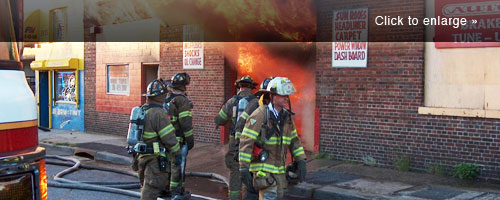You face challenging fires all the time. You’ve received training to assess different types of fires and determine the best firefighting approach. In each issue of Community Fire Protection News, we’ll show you a fire and ask you to make the call on a number of different measures. In this issue, you can view a video of an actual wildfire and see the resulting property destruction.
The video depicts California wildfires in the fall of 2008. The Marek Fire, Tea Fire, Sayre Fire, and Freeway Complex Fire destroyed thousands of homes and consumed thousands of acres. The Santa Ana winds fueled flames and intensified the damage. Hundreds of firefighters fought the fires, and aerial resources dropped fire-retardant chemicals.
Watch the video and reply to the questions below. They pertain to the wildland-urban interface — where wildland fires interact with residential and commercial buildings. We’ll include your answers in the next issue.
- What programs do you use to promote community solutions to prevent or reduce the impact of wildland-urban interface fires?
- What proactive steps can you take to become a Fire Adapted Community? According to the National Fire Protection Association, a Fire Adapted Community understands and accepts its wildfire risk and has taken steps to improve the safety and resilience of its homes, landscapes, infrastructure, and community assets to withstand a wildfire. Learn more about Fire Adapted Communities.
- How important is it to match the type of fire to the tactical plan?
Results from our Last Issue
This fire in an older one-story brick attached commercial building poses some common size-up problems.
In our last issue, we showed you the commercial building pictured here and asked you some questions. Here’s a summary of responses:
- Would a hazardous material (hazmat) unit be required at the scene?
- Hazmat may be required during overhaul or cleanup.
- Yes, if this is an automotive repair facility with unknown contents.
- Yes, unless the fire department did a preplan.
- Yes, as the building appears abandoned with unknown contents.
- What is the appropriate size hose line needed to attack this fire?
- 2.5 minimum to 3-inch hose with a blitz nozzle
- a nozzle capable of flowing at 500 gpm
- high-volume appliances that can flow water/foam
- What critical size-up factors would you use to determine an offensive or defensive operation?
- defensive heavy fire involvement to structure members
- amount of fire
- age and condition of building
- number of personnel on the scene
- water supply
- presence of fire walls
- any other known factors about the building
- What potential collapse indicators are apparent in the photo?
- smoke pushing through brick cracks
- heavy fire impinging on signage
- building appears to be boarded up, leaving the structural integrity and condition of the building in doubt
- large amount of fire
- length of time the fire may have been burning

